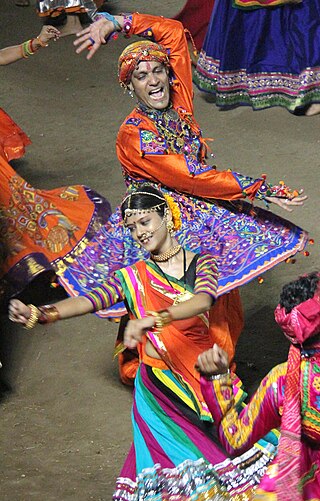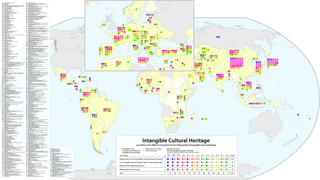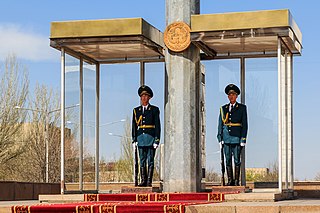
Bishkek, formerly Pishpek and Frunze, is the capital and largest city of Kyrgyzstan. Bishkek is also the administrative centre of the Chüy Region. The region surrounds the city, although the city itself is not part of the region but rather a region-level unit of Kyrgyzstan. Bishkek is situated near the Kazakhstan–Kyrgyzstan border with its population being 1,074,075 in 2021.

Kyrgyzstan, officially the Kyrgyz Republic, is a landlocked country in Central Asia, lying in the Tian Shan and Pamir mountain ranges. Bishkek is the capital and largest city of the country. Kyrgyzstan is bordered by Kazakhstan to the north, Uzbekistan to the west, Tajikistan to the south, and China to the east and southeast. With a population of 6.7 million, Kyrgyzstan is the 34th-most populous country in Asia, and the 4th-most populous country in Central Asia. Ethnic Kyrgyz make up the majority of the country's seven million people, followed by significant minorities of Uzbeks and Russians.

A kaftan or caftan is a variant of the robe or tunic. Originating in Asia, it has been worn by a number of cultures around the world for thousands of years. In Russian usage, kaftan instead refers to a style of men's long suit with tight sleeves.

Garba is a form of Gujarati dance which originates from the state of Gujarat, India. The name is derived from the Sanskrit term Garbha. Many traditional garbas are performed around a centrally lit lamp or a picture or statue of the Hindu goddess Shakti. Traditionally, it is performed during the nine-day Hindu festival Navaratri. Either the lamp or an image of the Goddess, Durga is placed in the middle of concentric rings as an object of veneration.

Roza Isakovna Otunbayeva is a Kyrgyz diplomat and politician who served as the President of Kyrgyzstan from 7 April 2010 until 1 December 2011, becoming the first female Central Asian head of state. She was sworn in on July 3, 2010, after acting as interim leader following the 2010 April Revolution, which led to the ousting of President Kurmanbek Bakiyev. She previously served as Minister of Foreign Affairs and as head of the parliamentary caucus for the Social Democratic Party of Kyrgyzstan.

The culture of Kyrgyzstan has a wide mix of ethnic groups and cultures, with the Kyrgyz being the majority group. It is generally considered that there are 40 Kyrgyz clans, symbolized by the 40-rayed yellow sun in the center of the flag. The red lines inside the sun visualise the crown of a yurt, the traditional dwelling of nomadic farmers, once the main population of the Central Asian area. The dominant religion of Kyrgyzstan is Sunni Islam (91%). The Russian population is Russian Orthodox.

A tubeteika is a Russian word for many varieties of traditional Central Asian caps. Tubeteikas are today worn in Tajikistan, Kazakhstan, Kyrgyzstan, and Uzbekistan, as well as in Muslim-populated regions of Russia and Azerbaijan. The skullcap worn by Uzbeks and Uyghurs is called a doppa and has a square base. It was a popular headgear among children throughout the USSR during the 1940s and 1950s.

Salakót is a traditional lightweight headgear from the Philippines that is commonly used during pre-colonial era up to the present day, used for protection against the sun and rain. Every ethnolinguistic group in the archipelago has their own variant, but they are all usually dome-shaped or cone-shaped and can range in size from having very wide brims to being almost helmet-like. They are made from various materials including bamboo, rattan, nito ferns, and bottle gourd. The tip of the crown commonly has a spiked or knobbed finial made of metal or wood. It is held in place by an inner headband and a chinstrap. The salakot hat also influenced the pith helmet used by European colonizers. Salakot or also spelled as salacot in Spanish and salacco in French is the direct precursor to the pith helmet widely used by European military forces in the colonial era.

Kyrgyz Premier League or OLIMPBET Premier League for sponsorship purposes is the division of professional football in Kyrgyzstan. It was created in 1992 after the Dissolution of the Soviet Union. The league is composed of eight teams. The most successful team is Dordoi Bishkek who have won the league thirteen times.

Although Kyrgyzstan’s mountains and lakes are an attractive tourist destination, the tourism industry has grown very slowly because it has received little investment. In the early 2000s, an average of about 450,000 tourists visited annually, mainly from countries of the former Soviet Union. In 2018, the British Backpacker Society ranked Kyrgyzstan as the fifth best adventure travel destination on earth, stating that the country was an adventure travel secret that is "bound to get out soon."

Lesbian, gay, bisexual, and transgender (LGBT) persons in Kyrgyzstan face legal challenges not experienced by non-LGBT residents. Both male and female same-sex sexual activity are legal in Kyrgyzstan, but same-sex couples and households headed by same-sex couples are ineligible for the same legal protections available to opposite-sex married couples.

Ala kiyiz or tekemet is an ornamenting style for textile floor- or wallcovering made by pressing wet, soaped wool of various colours together to make it felt. The chemical process of felting transforms the loose woolen fibers into a thick cloth. The felt carpet-making technique is a traditional folk art among the nomadic farming Kazakh, Kyrgyz and Mongolian peoples of the Tien Shan mountains and the steppes in Central Asia for over two and a half thousand years. From the various methods of ornamenting, ala kiyiz is among the widest spread, with shyrdak.

UNESCO established its Lists of Intangible Cultural Heritage with the aim of ensuring better protection of important intangible cultural heritages worldwide and the awareness of their significance. This list is published by the Intergovernmental Committee for the Safeguarding of Intangible Cultural Heritage, the members of which are elected by State Parties meeting in a General Assembly. Through a compendium of the different oral and intangible treasures of humankind worldwide, the programme aims to draw attention to the importance of safeguarding intangible heritage, which UNESCO has identified as an essential component and as a repository of cultural diversity and of creative expression.

Aitysh Public Fund is a charitable organization, which aims to promote and develop culture throughout Kyrgyzstan. Founded by public figure, producer and director Sadyk Sher-Niyaz in 2001 in the capital of Bishkek, the structure of the Fund consists of the Union of Improvised Singing ‘Aitysh’, Film Production Company ‘Aitysh Film’, International Film Festival "Kyrgyzstan - Land of Short Films", Manas Cinema network and Literary Organization ‘Kalemger’.

The Independence Day of Kyrgyzstan is the main state holiday in Kyrgyzstan. It is celebrated in Kyrgyzstan annually on August 31, the anniversary of its declaration of independence in 1991.

The xhubleta is an undulating, bell-shaped folk skirt, worn by Albanian women. It usually is hung on the shoulders using two straps. Part of the Albanian traditional clothing, it has 13 to 17 strips and 5 pieces of felt. The bosom and the part of the xhubleta covered by the apron are made out of crocheted black wool. The bell shape is accentuated in the back part.

The National Guard of Kyrgyzstan is the National Guard of the Armed Forces of the Republic of Kyrgyzstan. The national guard was founded on December 6, 1991, by order of President Askar Akayev. The troops took their first oath July 20, 1992. It carries out functions of a representative and protocol nature, protection and protection of strategic facilities of the country, liquidation of the consequences of natural disasters and emergency situations. In 2014, the Internal Troops of the Ministry of the Interior were absorbed into the National Guard as a result of military reforms in the country. This arrangement would stay until September 2018 when the two were separated and the Internal Troops were reformed. In 2016, the Commander of the National Guard was put onto the General Staff of the Armed Forces.

The Kyrgyz Air Force is the official air force of the Armed Forces of the Kyrgyz Republic. Its current commander is Colonel Kylychbek Aidaraliev. The official holiday of the air forces is Aviation Day on August 18.

The chedda of Tlemcen is a traditional Algerian dress, more precisely of the city of Tlemcen, but also worn in the west of the country, in particular in Oran and Mostaganem. A product of the local craftsmanship, it is worn by brides in Tlemcen for their wedding ceremony.



















